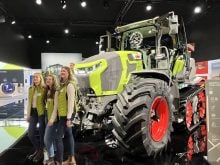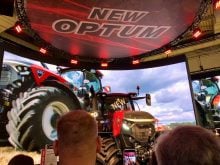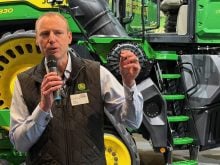Kris Mayerle runs eight high-horsepower tractors on his 21,000-acre farm, with an array of bright North American paint schemes.
Then, for 2018 he added a new olive green Fendt 1046.
The size of his farm and variety of crops, demands a lot of tractor power. But when you compare the dollar-to-power ratio, his off-green 460 h.p. Fendt does not really shine. The dollar-to-power ratio of a Versatile, for example, is much better. There must be a reason why a good manager like Mayerle, who was Saskatchewan’s Outstanding Young Farmer for 2008, bought the Fendt 1046. Not only did he buy a shiny new Fendt last year, but he is now waiting for another new Fendt to arrive shortly.
Read Also

Rural officials hopeful strychnine use will resume
The Saskatchewan Association of Rural Municipalities is taking a verbal commitment from the federal agriculture minister on strychnine use as a good sign.
“There are a lot of benefits to these front-wheel-assist high-horsepower tractors,” says Mayerle, owner of Greenleaf Seeds at Tisdale. His farm grows wheat, canola, oats, barley, peas, fababeans, hemp and flax.
About one third of the farm is in seed production. With the seed-processing plant and custom-harvesting businesses, Mayerle keeps about a dozen full-time employees busy year round.
He says one factor in favour of the Fendt is ease of operation. He can put any employee on the Fendt and the driver can handle it. He feels FWA tractors are easier to operate than articulated tractors, a significant factor with so many operators running the equipment.
“My first high-power straight frame tractor was an Agco Challenger track machine. It has a little more power than my Fendt. My local dealer gave me a good trade on the Challenger. He wanted some farmers up here to try these Fendt high-horsepower straight frame front-wheel-assist tractors.
“I already had a big John Deere front-wheel assist. It’s 400 horsepower, so I was already into this line of thinking. When I made the trade, I looked at the fact that I really didn’t need the Challengers 525 horse for the jobs I was doing.
“When our next Fendt arrives, it’ll replace our current John Deere front-wheel assist.
“I’ve found the Fendt is more universal than some of my other high-horsepower tractors. It cost a bit more, but we love it for the technology and the ride. So far, we’ve used it mainly for our pull-type fertilizer spreader and the 2,000 bushel grain cart. We put 750 hours on the Fendt last year. That’s more than we put on any of the other tractors. It seems to be everyone’s favourite tractor around here.”
He says the Fendt handles these heavy loads better than his articulated tractors, plus he can safely travel 35 mph when the cart is empty. His drivers say they appreciate the air ride cab and the front axle suspension. Doing light work, he says fuel consumption is less than his other tractors in the same power range.
Comparing the 460 h.p. straight-frame Fendt to his biggest 600 h.p. articulated tractor, Mayerle says, “We’ve pulled our vertical tillage machine with both tractors. I’d say the 460 h.p. tractor handles it as well as the 600 h.p. tractor.
“The big disadvantage of any straight-frame tractor is the size of the fuel tank. If you’ve got a 450 or 500 h.p. straight-frame tractor and use it to do the kind of heavy work it’s capable of doing, like pulling a big tillage implement, you burn a lot of fuel. The Fendt holds about 150 gallons. My center-articulated tractors hold double that amount.
“We were pulling that 50-foot Salford vertical till implement at nine mph, which is the same speed we pulled at with the 600 horse articulated tractor. But we only got 10 hours before we needed fuel. But I have to say, we really love the technology that’s designed into the Fendt.”
Mayerle says his drivers love the transmission and the throttle feature with a foot control that lets the driver pre-set the tractor speed to match the combine speed when pulling a grain cart.
With so much machinery to maintain, Mayerle says he appreciates the four-year full maintenance policy that’s standard on the tractor. The dealer comes out at each service interval and performs all work, including oil changes.
One of the most important implements of the Greenleaf farm is the 17-ton AgriSpread. Mayerle says they load it with 40,000 pounds of BioSol, a composted elemental sulfur product, and cover the entire farm every year.
He has to run the product through the spreader because it will plug the runs in a drill. In 2018, his drivers put more than 300 hours on the Fendt just spreading BioSol. The AgriSpread is set up for variable rate, which allows him to use it for top dressing urea on wheat and canola. He adds that the newer AgriSpread units also do sectional control.
“The Fendt comes standard all set up for air brakes, so we can hook it right up to the brakes on our big spreader. Whereas on my John Deere tractors, air brakes are an option.
“When I’ve driven it down the road at 50 km-h, I don’t feel un-safe, but we’ve never had an incident when we’ve really had to do an emergency stop. We only drive that fast when the cart or the spreader is empty. When there’s a load, we go about 20 or maybe 25 kilometres.”
















